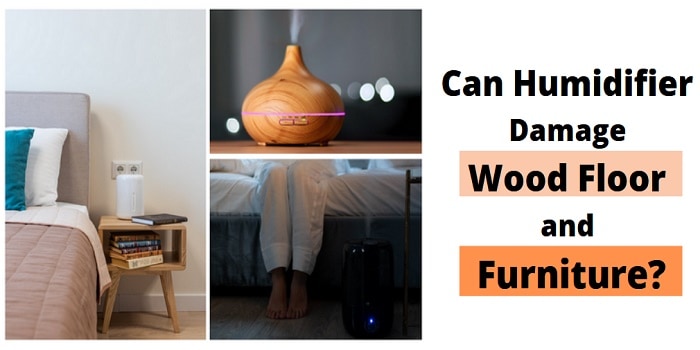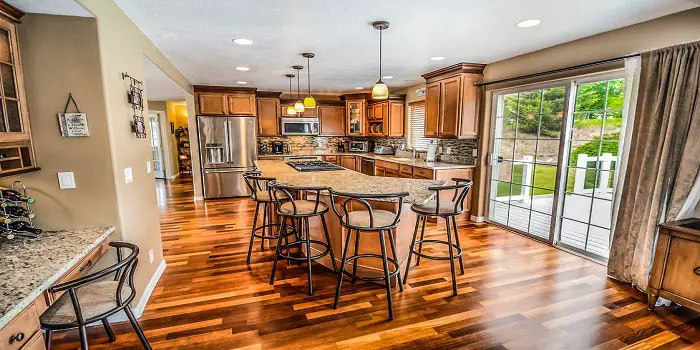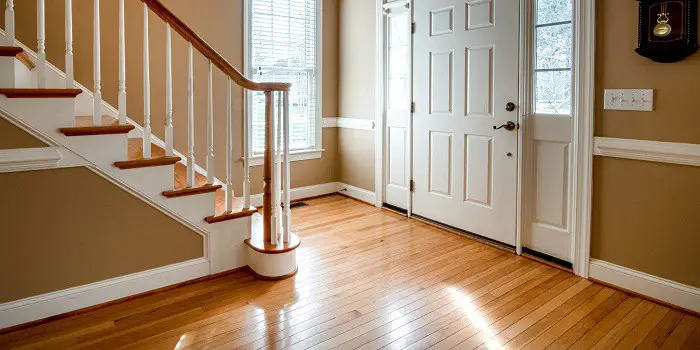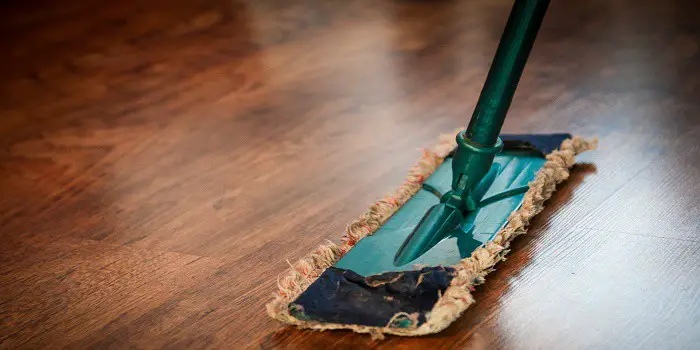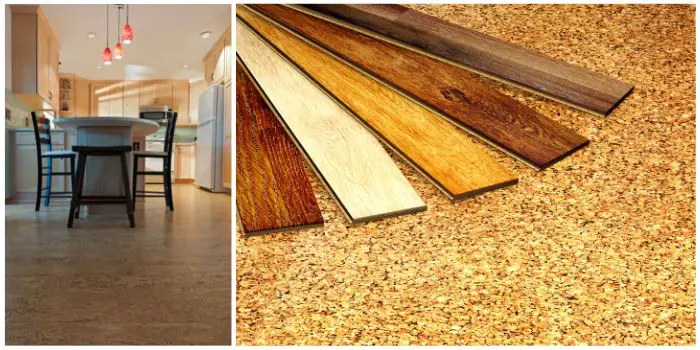
Cork is the natural material taken from the bark of cork oak trees and turned into a number of products like flooring and wine corks, to name a few.
To make cork flooring, leftover material from the production of wine cork is ground up, mixed with resin, and then made into planks, sheets, and tiles.
Cork is an increasingly popular type of flooring that has taken over the building industry lately. Modern cork flooring is highly versatile and can be installed in nearly any space. Like vinyl tiles, it allows for endless design possibilities, as skilled installers can use various colors to create unique, custom patterns.
With that said, there are a few disadvantages of cork flooring (along with various advantages) that you need to keep in mind when installing it in your home.
So, let’s dive in and check the pros and cons of these types of floors…
Advantages of Cork Floors
Below are just a few of the perks of using cork flooring:
1- Insulation
Cork bark provides natural thermal properties that make it a great alternative to heating wood floors. Cork has a 3.0 R-value for every inch of thickness.
This means it offers the same amount of warmth as a medium-weight puffy jacket. This helps to warm up your home and could potentially save you money on heating in other ways.
2- Easy to instal and refinish
Much like DIY wood flooring, cork floor planks are usually made with click-lock installation groves that make them as simple to install as faux wood flooring such as laminate and vinyl.
Because these planks create a floating floor, they can be installed over any existing floor, much like click-lock tile flooring.
When it comes time to refinish, the process is easy as long as the cork flooring is at least four millimeters thick. All you have to do is sand it, stain it again if necessary, and then put down a new coat of varnish.
Engineered and traditional cork alike can be refinished just like hardwood, as long as it has a thick veneer.
3- Eco-friendly, biodegradable, and sustainable
Cork is among the most environmentally friendly flooring options out there. After maturing for 20 years, cork oak trees are safe to harvest every nine or ten years for as long as 200 years.
On the other hand, it can take hardwood trees several decades before they mature. Once they are cut, that’s the end, with no further harvesting to be seen.
In this way, cork is a green, sustainable building material. Even quick-growing softwoods such as Douglas fir or pine aren’t nearly as sustainable as cork.
4- Super quiet and easy on the joints
Cork has sound-dampening properties that come from the tiny air pockets found in the material. For every cubic centimeter, there are around 40 million of these air pockets that trap quiet sound.
Cork is therefore great for living rooms, bedrooms, offices, music studios, gyms, dens, and beyond; it is the best flooring option for any room you want to be quiet.
The tiny air bubbles that are responsible for the cork’s quietness are also good for your body. Cork has a spongy but firm nature that is easy on your joints when you walk on it.
This extra support is thought to ease joint and back pain, which is good for those who spend a great deal of time on their feet.
It also creates an extra layer of safety for the disabled or elderly who may have a heightened risk of injury if they fall.
5- Naturally fire retardant
One of the biggest perks of cork flooring is its waxy, naturally occurring substance called suberin, which is incidentally named after the cork tree since cork contains so much of it.
This compound is a natural fire retardant. Cork will burn, but it will do so very slowly, and it won’t generate extra flames, therefore not spreading the fire.
6- Hypoallergenic and antimicrobial
Suberin also gives cork natural hypoallergenic and antimicrobial properties. Small insects such as dust mites, mildew, mold, small rodents, and dander avoid suberin.
Beyond that, if anyone in the household has allergies, having cork flooring can help.
Those with asthma or any other kind of respiratory issues can benefit from the durability and comfort of the flooring without it triggering any symptoms.
7- Great for disguising flaws and even self-repairing
Cork floors have a busy pattern that works wonders when hiding minor scratches and scruffs.
It is also self-repairing and will fill in its own dents with time. Keep in mind that only authentic cork will do this.
The cheaply manufactured cork found in big box stores is typically only printed with a cork appearance. This kind won’t hide any flaws like a real cork.
If the benefits of cork are ones you want and not just its appearance, it is important to buy cork from a reputable manufacturer. This will ensure you are actually purchasing genuine high-quality cork and therefore are getting all of its many perks.

Disadvantages of Cork Flooring
Much like anything else, there are always a few drawbacks to using cork flooring.
They aren’t deal-breakers, but it is still a good idea to get acquainted with their flaws, so you are prepared for what might happen in the future.
1- Susceptible to sun fading
One of the most common drawbacks of cork flooring is that it takes on damage from the sun rather easily. Long-term exposure to direct sunlight does turn the cork a yellowish color and make it fade.
UV lamps used for the purpose of skin treatments, disinfection, and indoor gardening will also cause the cork to fade.
For this reason, cork might not be the best option for greenhouses, tanning salons, or sunroom flooring.
Even so, this disadvantage is easy to avoid. All you need to do is buy cork products that have UV-resistant finishes applied to them.
2- Doesn’t work well in humidity
Unlike hardwood flooring, which will expand with its grain all in one direction, cork flooring will contract and expand in all directions. This is not good in humid environments.
If you live somewhere that is dry in the winter but wet in the summer, cork flooring might suffer for it. Its sensitivity to humidity makes it one of the biggest disadvantages for use as a floating floor.
For this reason, if you live in environments like this and go for cork, you may want to choose a floor you can glue down.
All of that said, you can still enjoy cork flooring in a humid environment. You could invest in a humidistat and then keep an eye on the moisture level in your home.
You could also hook up a humidistat to your HVAC system along with a dehumidifier and balance the moisture level in your home more easily.
3- Engineered cork floors aren’t as environmentally friendly
If you know anything about the disadvantages of engineered wood, then you know that many of the drawbacks of engineered wood are centered around its eco-friendliness. The same can be said of cork flooring.
As mentioned, engineered cork is made by bonding the cork with a layer of fiberboard through the use of adhesives. Fiberboard comes in medium-density and high-density options, which are usually used in engineered cork flooring.
High-density fiberboard is simply wood pulp that has been pressed into sheets in a high-pressure environment. Organic or synthetic adhesives are commonly used in this process.
4- Water absorbent
There is a lot of talk about cork absorbing water easily, some claiming as easily as a sponge. The truth is that cork is one of the more water-resistant wood floor options available.
Not all cork flooring is waterproof, and not all cork flooring is water-resistant, but that doesn’t mean that every single instance of cork flooring is going to soak up water.
Engineered and solid cork flooring both have different amounts of water resistance that depend on the product itself. It also depends on the installation method, varnish, and manufacturer.
Generally speaking, cork is relatively resistant to water, but it won’t ever be the best product to use as bathroom flooring or mudroom flooring.
Cork is as water-resistant as some types of faux hardwood floors such as traditional laminate, but it isn’t anywhere near as waterproof as certain specialty flooring products.
5- Can be easily dented or scratched
As mentioned, cork is a flooring option that is relatively scratch-resistant.
Scratches and dents aren’t a big issue, especially because the busy nature of the appearance of cork hides imperfections easily. It is also self-repairing in time, as mentioned.
However, sharp objects can definitely slice it up. Blunt objects such as heavy appliances or furniture can also breathe through their finish and cause permanent damage to the material.
If you’re looking for wood flooring that can stand up to a little damage, such as in homes with dogs, cork might not be the best option for you.
On the other hand, this can also be said for many different fake wood flooring options. When it comes to the ability to repair cork, it can be some of the most durably wood flooring available.
6- Requires regular maintenance and sealing
Cork flooring will have to be resealed and maintained at least once every couple of years.
A worn-out varnish will make cork flooring more vulnerable to water damage, and if there is no sealant, these floors can crumble.
However, sweeping, mopping, vacuuming and a no-shoes policy in the house regularly can often prolong the life of the sealant.
7- The staining process can make an uneven appearance
The variations in the texture of cork can be drawn out by a stain. This is only really a problem if you intend to stain flooring once it has already been installed.
You can work around this by buying prefinished cork planks to work with.
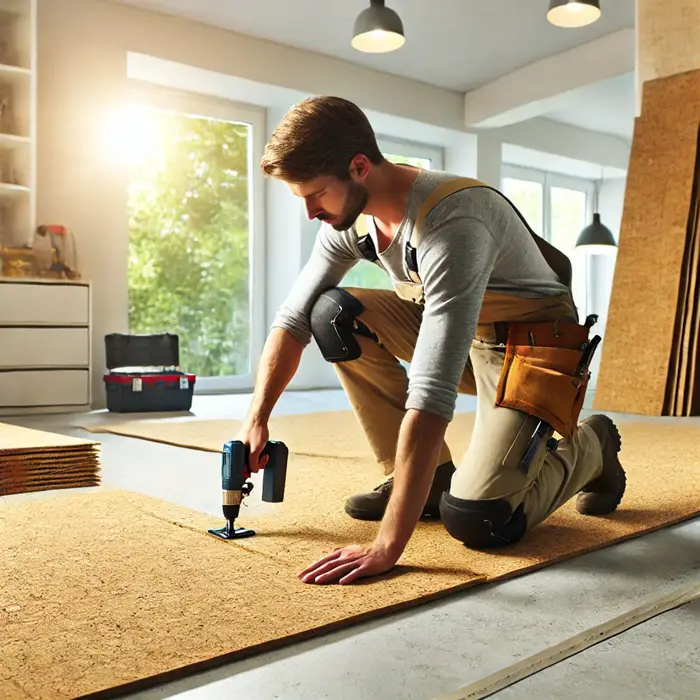
Glue-Down vs. Floating Cork Flooring – What’s Better?
When choosing cork flooring, one of the key decisions is selecting between glue-down and floating installation methods. Each method has its own advantages and limitations, making it important to understand which one best suits your needs.
- If you need a permanent, durable solution for high-traffic areas and are comfortable with a more involved installation process you should pick glue-down cork flooring.
- Choose Floating Cork Flooring if you prefer ease of installation, flexibility, and moisture resistance, especially for DIY projects or rental properties.
| Feature | Glue-Down Cork Flooring | Floating Cork Flooring |
|---|---|---|
| Installation Method | Requires adhesive and subfloor prep | Click-and-lock mechanism, no glue needed |
| Ease of Installation | More complex, requires expertise | Simple, DIY-friendly |
| Durability & Stability | More stable, less movement | Can expand/contract with temperature changes |
| Moisture Resistance | Needs proper sealing | Better resistance with moisture-proof core |
| Insulation (Sound & Heat) | Stronger insulation due to direct bonding | Slightly less effective |
| Removal/Replacement | Difficult to remove | Easy to disassemble and reinstall |
| Customization | Can create unique patterns | Limited to plank-based designs |
| Best Use Case | High-traffic areas, long-term installations | DIY projects, rental properties, moisture-prone areas |
Keep in mind that cork is usually best installed by professionals, especially the glue-down variety. So, those who enjoy DIY flooring may not appreciate the nature of cork because gluing down cork flooring isn’t a simple installation.
There are many things to consider when it comes to this, like underlayment and level subfloors, that can be daunting if you aren’t familiar with the processes.
Chances are, you will need to enlist the help of a professional, and paying for them to install the floors will cut into any budget you may have.
One of the easiest ways to sidestep this is to instead buy engineered cork floors. The price needed to install this type of engineered cork flooring is not unlike that of the price to install engineered hardwood floors.
The national average complete with installation tends to be about $1,000 for every 100 square feet, which is a little less than half the average price for replacing hardwood but a little more than installing bamboo flooring.
Cork Flooring Costs and Popular Brands – Worth Every Penny?
Cork flooring isn’t just a sustainable choice—it’s also a stylish one. But how much will it set you back? Well, cork planks or tiles typically range from $3 to $9 per square foot, depending on thickness, quality, and finish.
When it comes to installation, floating floors are the budget-friendly option, costing an extra $2 to $4 per square foot. However, if you opt for a glue-down installation, be prepared to double that expense—putting it in the same price range as bamboo flooring but still a bit cheaper than most hardwood options.
If you’re looking for a deal, big-box home improvement stores offer cork flooring at reasonable prices. But for top-tier variety and unique selections, specialty flooring stores are your best bet. Here are some leading brands to check out:
- WE Cork – Whether you prefer planks or tiles, floating or glue-down, WE Cork has a wide range of styles and shades to suit your taste.
- iCork Floor – A factory-direct distributor that sells straight to consumers through its website, offering great deals on floating and glue-down cork flooring.
- APC Cork – One of North America’s biggest cork flooring suppliers, boasting 87 styles of floating and glue-down tiles and planks, available through specialty flooring retailers.
Final Thoughts
Trendy, eco-friendly, forgiving, and hypoallergenic, cork flooring is a great option for many households. If you are concerned about the long-term resale value of the house, you may want to avoid cork flooring. However, if you want to take advantage of all of its many benefits in the short term, then cork flooring is great for your space.
Cork flooring may cost a bit more upfront, but with its durability, comfort, and eco-friendly appeal, it’s an investment that pays off—one step at a time!
Share the post "Cork Flooring: Pros & Cons (Costs and Popular Brands)"

Hi, I am Mark Garner a professional carpenter, woodworker, and DIY painter. I live in the small city of Peoria, Arizona as a semi-retired woodworker. I have started this blog with a simple motive to help you with my wood experience in this sector. If you like to know more about what I love doing and how it all got started, you can check more about me here.

